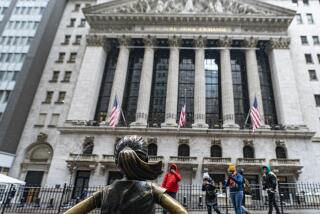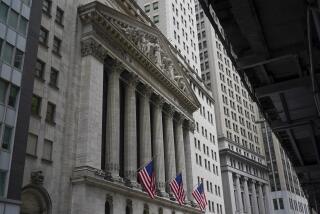The bull market turns 2, but can it make it to 3?
Hold the champagne. For the second anniversary of the bull market in stocks, a barrel of crude might be a better gift.
As Wall Street marks two straight years of share price gains, investors who expect more to come are betting that oil’s latest surge is just another minor obstacle — like so many others that have failed to halt the rally for long.
Since stocks bottomed on March 9, 2009, in the aftermath of the financial-system crash, the average New York Stock Exchange issue has nearly doubled in price. By some measures, the speed of the rebound has been faster than any market run-up since the 1930s, defying doubters who have repeatedly predicted imminent collapse.
The global economy’s revival has lifted the Standard & Poor’s 500 index of big-name stocks 95% over the last two years, boosting the market value of the S&P 500 shares to $12.06 trillion now from $5.9 trillion at the 2009 low.
That has done a lot of repair work on ravaged 401(k) retirement accounts, at least for investors who’ve been willing to stay aboard.
The market Tuesday showed more of the resilience that has defined the rally since the dark days of 2009. The Dow Jones industrial average rose 124.35 points, or 1%, to 12,214.38 as oil prices pulled back modestly from the 21/2-year high reached Monday.
Crude slipped 42 cents to $105.02 a barrel in New York after Kuwaiti officials said OPEC was discussing whether to hold an emergency meeting on production, as Libyan oil output remains sharply curtailed by the revolt there.
Although stocks have struggled as oil has soared 22% since mid-February amid escalating unrest in the Middle East and North Africa, the Dow is down just 1.4% from its 32-month high of 12,391.25 reached Feb. 18.
The market’s continuing strength has encouraged investors such as Ray Uhler, a 72-year-old Rancho Santa Margarita retiree. He said he has seen his portfolio bounce back sharply over the last two years, in part because he picked up bargains at the market’s lows.
Uhler said he bought Ford Motor Co. shares at $2 after the stock plummeted during the recession. Ford shares closed Tuesday at $14.47.
“I haven’t dumped our stocks and gotten out of the market and gotten into cash or bonds,” Uhler said. “I look upon a market decline as a buying opportunity.” He said he expected the economy to continue to improve, driving stocks higher.
To many Wall Street bears, however, rocketing oil prices look like the blow they’ve been expecting to finish off the bull market.
If crude stays elevated — lifting gasoline prices that already are topping $4 a gallon in California — it could put a painful squeeze on U.S. consumer spending, which still accounts for 70% of the economy.
“The consumer is the Achilles’ heel,” said Doug Kass, who heads money manager Seabreeze Partners in Palm Beach, Fla.
With stocks, he said, “it seems to me we’re far closer to the end of the move.”
But he also acknowledges that the market has left the bears in the dust over the last two years since the Dow bottomed at 6,547.05.
Where the pessimists were wrong, Kass said, was in underestimating the powerful rebound in corporate earnings since the recession.
After slashing their expenses via brutal layoffs and other cost-cutting as the economy tanked, many companies quickly benefited as sales began to turn up with the recession’s end in mid-2009.
Also, banks and other financial companies have posted some of the biggest turnarounds in earnings since 2008, helped by government capital injections and the Federal Reserve’s near-zero short-term interest rates.
Financial stocks in the S&P 500 have shown the biggest advance among the 10 major index sectors over the last two years, rallying 169% on average. But they also were the biggest losers in the last bear market.
Overall, operating earnings of the S&P 500 companies soared 47% in 2010 from 2009, providing a solid underpinning for the bull market.
“Costs are down and profits are up, and profits are what move the markets,” said Marc Pado, U.S. market strategist at brokerage Cantor Fitzgerald.
This year, analysts at Standard & Poor’s expect the S&P 500 companies’ operating earnings to rise 15%, a gain that Pado believes will push stocks higher.
The bulls also believe that equities remain reasonably valued relative to earnings. The S&P 500 index’s price-to-earnings ratio is 13.7 based on estimated 2011 earnings.
But that assumes that the estimates are on target. If the economy weakens, profit forecasts could come down in a hurry.
Kass sees the economic recovery so far as a story of “the schism between the haves — large corporations — and the have-nots, the middle class.”
Yet those same big companies, he noted, are dependent to a large degree on U.S. consumer spending, which is threatened by mushrooming energy costs.
Market bears also point to another major risk to the economic recovery: the end of fiscal and monetary stimulus programs.
The economy has been lifted in part since mid-2009 by the sea of stimulus money that poured from the federal government and the Federal Reserve.
Now, Republicans in Congress seem intent on paring the federal budget deficit, draining away fiscal stimulus.
At the same time, the Fed is scheduled in June to finish its injection of $600 billion into the financial system via purchases of Treasury bonds, a program it launched in November to try to buttress the economy and financial markets.
“All of our problems haven’t gone away — they’ve just been papered over with the thing that got us in trouble in the first place: more debt,” said Steve Hochberg, chief market analyst at research firm Elliott Wave International in Gainesville, Ga.
Still, many professional investors aren’t willing to give up on the bull. If it ends now, the S&P 500’s 95% rise from the bear-market low would put it about in the middle of bull-market gains since World War II.
One argument for a longer advance is that the global economy began the year with significant momentum, particularly as measured by indexes of manufacturing activity.
In the U.S., car sales were surprisingly strong in February, a sign of consumers’ willingness to spend.
And the missing link in the recovery — job growth — finally may be kicking in.
Rising takeover activity also has bolstered the market as companies that are flush with cash from the profit boom look to put that money to work.
Nick Sargen, who oversees $38 billion as chief investment officer at Fort Washington Investment Advisors in Cincinnati, admits to being worried about the high level of market optimism that shows up in sentiment surveys of professional and individual investors.
“Usually that’s a sign that the bull is winding down,” he said.
As oil prices have jumped, Sargen said, he has been in “wait-and-see mode” with regard to stocks, rather than adding to his portfolio. If crude continues to climb, he’s likely to cut back on equities, he said.
“If I think we’re headed for $120 oil, I’m going to start taking some chips off the table,” he said.
But if oil stabilizes or declines it could reinvigorate the bulls’ case, Sargen said.
“I’ve got more confidence in the economy today than I did a year ago,” he said.
Yet even if the rally resumes soon, most optimists warn that stocks’ pace is likely to continue to slow.
The Dow shot up 61% in the first year of the market’s advance, but the gain in the second year was 16%, through Tuesday.
Few analysts believe the market will rise enough this year to get the Dow back to its all-time high of 14,164.53 reached on Oct. 9, 2007. That would require a 16% gain.
But with cash accounts paying close to nothing and yields on many bonds in low- to mid-single digits, stocks could continue to look better than most of the alternatives, said Charles Carlson, head of Horizon Investment Services in Hammond, Ind.
“I still get it all the time from people — they say, ‘Are you insane? This market can’t go up,’” he said.
“There’s still a lot of skepticism out there,” Carlson said. And that means, he said, there’s money being kept idle by people who are yet to be convinced that equities are worth the risk.






